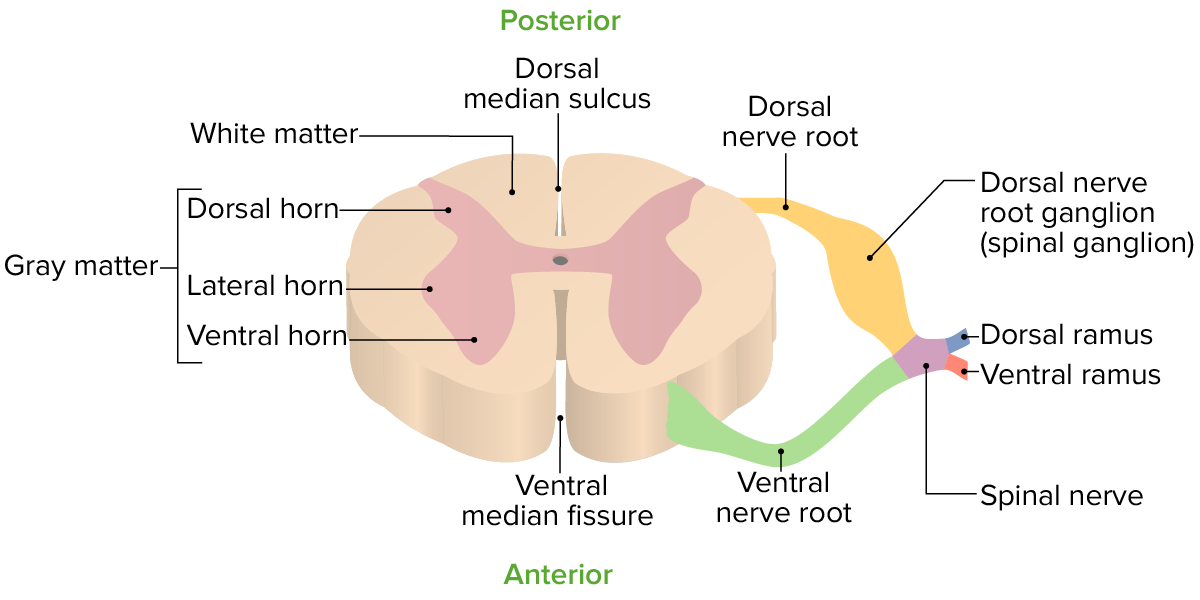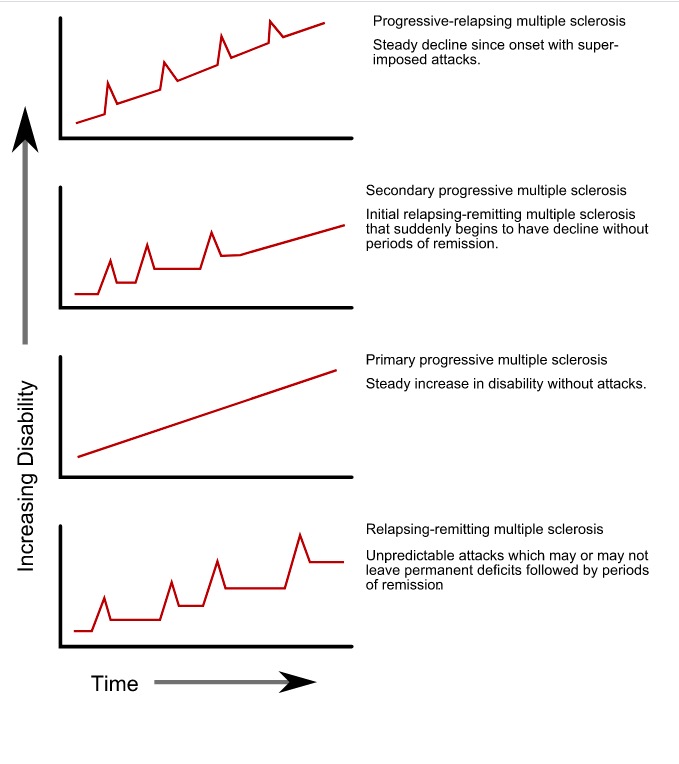Playlist
Show Playlist
Hide Playlist
Overview of CNS Inflammatory Diseases
-
Slides Multiple Sclerosis Inflammatory Disorders of the CNS.pdf
-
Download Lecture Overview
00:01 So let's walk through some of the types of CNS inflammatory conditions we can see the monophasic illnesses, the recurrent illnesses. 00:09 And let's think a little bit more about the predominant cell type that's involved and the typical conditions that we see. 00:16 Let's start with monophasic conditions. 00:19 These are our clinically isolated syndromes. 00:22 Patients present with a single attack, subacute onset of neurologic deficits that peaks over the course of a couple of weeks and then returns typically back to normal. 00:31 We call these the clinically isolated syndrome because there is a isolated syndrome that doesn't recur. 00:37 This syndrome can be categorized based on the area of the nervous system that's involved. 00:43 So clinically isolated optic neuritis is an optic neuritis that occurs with one attack. 00:48 The patients develop new vision changes or vision loss often with red or color desaturation and pain with eye movements. 00:55 Those are the classic symptoms of an optic neuritis. 00:58 We may do an MRI and see enhancement of the optic nerve or an LP and see inflammation within the nervous system. 01:04 Because again, the optic nerves are an extension of the brain and they're connected to that same spinal fluid space. 01:10 In clinically isolated optic neuritis, there's one event it's a monophasic illness. 01:14 We worry in a patient's first presentation that they could develop new events and watch closely for those and look for signs of evidence of possible or recurrence or risk of recurrence. 01:26 When the brainstem is affected is a clinically isolated brainstem syndrome. 01:31 When the spinal cord is affected is a clinically isolated transverse myelitis. 01:36 And when there are no symptoms and we see it just with imaging, that is coined radiographic isolated syndrome. 01:45 Those are the clinically isolated syndromes where there is a single area of brain that is involved and not a diffuse or multifocal area that's involved. 01:53 We can also see monophasic inflammatory disorders where there's dissemination of symptoms over nearly the entire neuro axis or central nervous system. 02:03 The most common of those is the acute demyelinating encephalomyelitis, which is called ADEM. 02:09 This is a diffuse multifocal process that involves the brain and the spinal cord. 02:14 That's why it's an encephalomyelitis. 02:17 It's an inflammatory disorder. 02:18 That's why the name ends with itis. 02:20 There's inflammation in the nervous system. 02:23 And there's demyelination. 02:24 We see demyelination on MRI and spinal cord. 02:28 MRI of the spine and MRI of the spinal cord. 02:31 We see increased protein with the spinal fluid and with an LP. 02:35 And those are all suggestive of an underlying autoimmune condition and demyelination. 02:40 It's follows a monophasic course with sub acute onset, peaking in several weeks, and then often improving back to normal and rarely recurs, but can and in various rare exceptions. 02:52 And then there's a second condition called Acute hemorrhagic leukoencephalitis or Hurst encephalitis, which is just a hyperacute and fulminant form of ADEM. 03:00 And again, these are where there's an attack all over the central nervous system one time as a monophasic course. 03:09 Those monophasic conditions are different from the recurrent conditions. 03:14 And we can categorize recurrent inflammation in the nervous system based on the predominant cell type that's involved. 03:21 There are recurrent T cell predominant syndromes, and this is where there's recurrent episodes of relapses and remissions. 03:29 And the predominant cell type that's involved that we see is a T cell process. 03:33 Now when the immune system is activated, there's always some degree of T cells and B cells and a lot of other things in between. 03:40 But the primary cell type that's mediating this problem are T cells. 03:44 The classic example of this is multiple sclerosis. 03:47 And there are a number of types or categories of multiple sclerosis that we can see. 03:52 We can see relapsing remitting MS, which is depicted on the schematic on the left. 03:56 We can see relapsing progressive MS, where there's not returned to baseline. 04:01 Patients develop persistent fixed deficits during their remissions. 04:06 We can see secondarily progressive MS, which you see in the depiction on the right, where patients have a period of relapses followed by progression over time. 04:14 And that's where this inflammatory disorder is taking on a degenerative flavor. 04:21 And Primary Progressive MS doesn't start with relapses and remissions at all it just progresses steadily over time. 04:29 MS is driven by a T cell activation, and it is our produce a prototypical T cell predominant recurrent CNS autoimmune condition. 04:41 What about recurrent B cell predominant disorders? And again, these are primary CNS neuroinflammatory disorders where the problem is really with the B cells. 04:49 B cells have to be turned on by T cells and they do interact with the T cells but we can measure the antibodies and that's what gives these conditions their name and diagnostic testing. 05:00 There are two classic examples. 05:01 One, is NMO or neuromyelitis optica. 05:05 And the second is MOG antibody disorder. 05:08 We think about those and some of the typical diseases are NMO or Devic's disease, which is another name for that condition. 05:15 There is NMO spectrum disorders, which are some of the secondary CNS autoimmune conditions that we'll talk about, in MOG antibody disorder. 05:23 And these should be the three things you think about when we're thinking about recurrent B cell predominant, CNS autoimmune conditions. 05:31 And then there's also another or also other CNS neuroinflammatory disorders that don't fall strictly in those other categories. 05:38 There are some macrophage mediated, macrophage predominant conditions like neurosarcoidosis Erdheim-Chester, Histocytosis, and Rosai-Dorfman disease. 05:48 Here, macrophages are activated. 05:50 There's also T and B cells that are a part of that process, but the primary immune mediator that infiltrates into the brain are the macrophages. 05:58 We can also see some T cell variants or variants of multiple sclerosis, There's a Marburg, Schider's, Balo's concentric sclerosis variant, chronic myelopathy, and progressive ataxia that can also be observed. 06:11 And then some other conditions that are CNS autoimmune condition, Neuro-Behcet's, and connective tissue disease associated CNS-autoimmunity. 06:19 We can see some mixed polyclonal B/T cell. 06:22 This disease is an example. There is Castleman's disease and primarily B cell mediated disorders, like a plasma cell granuloma would also be a consideration. 06:31 And these are significantly less common than the other disorders that we discussed. 06:35 And I really encourage you to focus on things like MS, NMO, and MOG antibody disease as well as the clinically isolated syndromes.
About the Lecture
The lecture Overview of CNS Inflammatory Diseases by Roy Strowd, MD is from the course Multiple Sclerosis (MS) and Inflammatory Disorders of the CNS.
Included Quiz Questions
Which of the following are typical characteristics of multiple sclerosis? (Select all that apply.)
- It is a recurrent type of CNS inflammation.
- It is a monophasic type of CNS inflammation.
- It is a B cell–dominant disease
- It is a T cell–dominant disease.
- It does not cause permanent neurologic damage.
Neuromyelitis optica is characterized by... (Select all that apply.)
- ...recurrent attacks.
- ...being a subtype of multiple sclerosis.
- ...being associated with some vaccines.
- ...predominance of B cells in the inflammatory infiltrates.
Customer reviews
1,0 of 5 stars
| 5 Stars |
|
0 |
| 4 Stars |
|
0 |
| 3 Stars |
|
0 |
| 2 Stars |
|
0 |
| 1 Star |
|
1 |
1 customer review without text
1 user review without text





